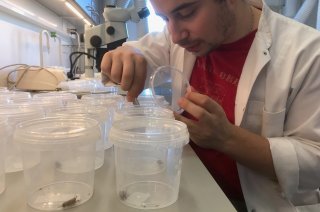
PhD project
Project 3 Interactions between pathogens infecting crickets: who paves the way for the other? (DK)
Pathogens, especially the Acheta domesticus densovirus (AdDV), are threatening the mass production of house crickets Acheta domesticus. This pathogen is present in almost every cricket stock in a covert state. When it becomes virulent, AdDV eradicates the populations rapidly. I will examine the role of co-infections with bacterial and fungal entomopathogens and other stressors as possible triggers for the virulence of AdDV.
Insects have great potential to make our food chains circular. The house cricket Acheta domesticus is a promising candidate for food and feed purposes, but viral pathogens can cause epizootics in cricket rearings. The A. domesticus densovirus (AdDV) is the main threat, which already caused serious losses in commercial cricket production. AdDV is present in most known A. domesticus stocks, mostly in a covert state. During my research, I am exposing crickets to bacterial (Serratia marcescens) and fungal (Metarhizium brunneum) entomopathogens to see if these could trigger the AdDV virus outbreaks.
The aims of the project are:
(1) Compare the effects of co-infections (bacterium-fungus, virus-fungus and bacterium-virus) on cricket mortality, growth, developmental time and behaviour
(2) Evaluate synergistic versus antagonistic effects of pathogens on cricket fitness
(3) Determine if and how vertical virus transmission occurs
I started with the culturing and exposure system for the selected fungal and bacterial pathogens and test those as single pathogen infections in the crickets. This will allow to determine non-lethal dosages, as the aim is to stress the individuals to a point where AdDV becomes active. I have also confirmed AdDV presence in the cricket stock used, by screening different body parts, hemolymph and frass of the crickets. Throughout the project, I will focus on collecting quantitative data, by using and developing RT qPCR methods for each of the pathogens. This will be done preferably using either cricket frass or hemolymph, allowing for a non-destructive sampling method during the co-infection experiments. Different immune assays, such as PO activity and lysosome-like activity will be used to measure the status of the immune systems during the infections. Based on the data collected, I will set up a model on the co-infections, aiming to gain insight into development of disease outbreaks. In the last phase of the project, virus transmission will be examined, where I will determine if and how vertical transmission of the virus occurs.
